
Posts Tagged: deficiency
Watch Those New, Yellow Flush Leaves Closely
Lime-induced Iron Chlorosis: a nutritional challenge in the culture of several subtropical perennial crops in California
Elizabeth Fichtner, UCCE Tulare County and Rachel Elkins, UCCE Lake and Mendocino Counties
Spring, and new leaves are coming out, but this could, but yellow could be a sign of iron chlorosis, as well.
Although iron (Fe) is the 4th most abundant element in the lithosphere, Fe deficiency is among the most common plant micronutrient deficiencies. Fe deficiency in plants is common in calcareous soils, waterlogged soils, sandy soils low in total Fe, and in peat and muck soils where organic matter chelates Fe, rendering the element unavailable for plant uptake. In California, lime-induced Fe deficiency is often observed in soils and irrigation water containing free lime, and is exacerbated by conditions that impede soil drainage (ie. compaction, high clay content), resulting in reductive conditions. Given that over 30% of the world's soils are calcareous, lime-induced Fe deficiency is a challenge in numerous perennial cropping systems including: grapes, pears, apple, citrus, avocado, pecans, and stone fruit (prune, almond, apricot, peach, nectarine, cherry).
In most soils, Fe oxides are the common source of Fe for plant nutrition. Solubility of Fe oxides is pH dependant; as pH increases, the free ionic forms of the micronutrient are changed to the hydroxy ions, and finally to the insoluble hydroxides or oxides. In calcareous soils, the bicarbonate ion inhibits mobilization of accumulated Fe from roots to foliage and directly affects availability of Fe in soil by buffering soil pH. When irrigation water is also high in bicarbonate, probability of Fe deficiency is enhanced because bicarbonate is continuously supplied to the soil, and more importantly, the roots may become crusted with lime as water evaporates, thus inhibiting root growth and function. Inside the plant, bicarbonate inhibits nutrient translocation from roots to aboveground plant parts. The adverse effects of high bicarbonate levels are exacerbated in very saturated, very dry, or compact soils, where bicarbonate levels increase concurrent with diminished root growth and nutrient uptake.
Symptoms of Fe deficiency in plants
Fe is immobile in plants; therefore, symptoms appear in young leaves. Interveinal chlorosis (Figure 1) is the main symptom associated with Fe deficiency, followed by reduced shoot and root growth, complete foliar chlorosis, defoliation, shoot dieback, and under severe conditions may result in tree mortality. Overall productivity (yield) is reduced, mainly from a reduced number of fruiting points.
Plant Adaptation
Plant species and cultivars vary in their sensitivity to Fe deficiency, and are categorized as either "Fe-efficient" or "Fe-inefficient". Fe-efficient plants have Fe uptake systems that are switched on under conditions of Fe deficiency. Fe-inefficient plants are unable to respond to Fe deficient conditions. All Fe-efficient plants, except grasses, utilize a Fe-uptake mechanism known as Strategy 1. Strategy 1 plants decrease rhizosphere pH by release of protons, thus increasing Fe solubility. Some plants may excrete organic compounds in the rhizosphere that reduce ferric iron (Fe3+) to the more soluble ferrous (Fe2+) forms or form soluble complexes that maintain Fe in solution. Additionally, roots of Strategy 1 plants have specialized mechanisms for reduction, uptake, and transfer of Fe within the plant. Strategy 2 plants (grasses) produce low molecular weight compounds called phytosiderophores which chelate Fe and take up the chelated Fe with a specific transport system.
Amelioration of Fe chlorosis
Planting sites in calcareous soils should be well drained to provide optimal conditions for root growth and nutrient uptake. Waterlogged and compact soils contain
more carbon dioxide, which reacts with lime to form even more bicarbonate. These conditions, as well as very dry soils, also inhibit microbial activity which aids in
solubilization and chelation of Fe. Prior to planting, soils and water should be tested to determine the pH, lime equivalent, and bicarbonate concentration. Bicarbonate concentrations greater than 3 meq/L in irrigation water increase the hazard of lime accumulation on and around roots. If high bicarbonate water must be used, the pH must be adjusted to 6.0-6.5 to dissolve the bicarbonate and prevent it from negating the effects of soil-based treatments. In microsprinker and drip systems, acidification of irrigation water will also reduce the risk of emitter clogging, a common problem at bicarbonate levels over 2 meq/L. The cost of reducing the pH of irrigation water will more than compensate for the savings incurred from avoiding wasted investment in failed soil- and plant-based remedies. Systems can be set up to continuously and safely inject water with acids such as sulfuric, urea-sulfuric, or phosphoric during irrigations. Specific choice and rate will depend on crop, soil type, other nutrient needs, availability, and cost. Downstream pH meters are available to continuously adjust rate of acid use. Acetic and citric acid can be utilized by organic growers.
Soil based pre-plant treatments to reduce pH include elemental sulfur (S) and acids as mentioned above. It is only necessary to treat a limited area near the root zone to ameliorate symptoms because the tree only needs to take up a small amount of Fe. Material can be shanked in or banded and incorporated in the prospective tree row. One ton of elemental sulfur per treated acre is needed to mitigate three tons of lime, and may need to be re-applied every 3 to 5 years after planting. The addition of organic matter such as well-composted manures will benefit poorly drained or compact soils by increasing aeration for better root growth, fostering chelation of nutrient cations, and reducing pH (depending on source material).
If possible, choose a Fe efficient species or cultivar. In perennial systems, lime-tolerant rootstocks may be the first line of defense in combating Fe deficiency. Some rootstocksmentioned are peach-almond and Krymsk-86 for stone fruit, Gisela 5 for cherry, and Pyrus communis for pear. Ongoing research studies in Europe focus on screening rootstocks of grape and olive for lime tolerance.
Once soil and water quality improvements are made, post-plant management strategies may also be implemented to ameliorate lime-induced Fe chlorosis in the short term. Soil can be acidified as described above. Individual trees can be treated by digging four to six 12-24 inch
holes around the drip line and burying a mixture of sulfur and Fe fertilizer. Historically, two principal methods have been utilized: 1) foliar application of inorganic Fe salts (ie. ferrous sulfate), and 2) soil or foliar application of synthetic chelates. Application of Fe salts to foliage may have mixed results due to limited penetration of Fe into leaves and inadequate mobilization within the plant. Use of Fe chelates may be of benefit; however, they are expensive and pose an environmental concern due to their mobility within the soil profile. Because soil lime interferes with Fe mobility with the plant, repeat application of inorganic Fe salts or Fe chelates may be necessary throughout the growing season.
Choice of nitrogen (N) fertilizer may also influence solubility of rhizosphere Fe. When N is applied in the ammonium form (NH4+), the root releases a proton (H+) to maintain a charge balance, thus reducing rhizosphere pH. Alternately, fertilization with nitrate (NO3-) results in root release of hydroxyl ions (OH-), resulting in an increase in rhizosphere pH. Solubility of Fe3+ increases 1000 fold with each one unit decrease in pH; therefore, fertility-induced rhizosphere pH changes may significantly influence Fe availability.
New methods for amelioration of Fe chlorosis are under investigation. For example, container studies have demonstrated that inter-planting sheep's fescue, a Strategy 2 plant, with a Fe-inefficient grape rootstock may ameliorate Fe chlorosis in grape. In this system, the grass produces a phytosiderophore that enhances Fe availability to the grape. Additionally, soil amendment with Fe3(PO4)2• 8H2O), a synthetic iron(II)-phosphate analogous to the mineral vivianite, has been effective at preventing Fe chlorosis in lemon, pear, olive, kiwi, and peach. Vivianite has a high Fe content (~30%) and serves as a slow release source of Fe in calcareous soils.
Figures below: Shoot dieback in citrus and iron chlorosis in avocado
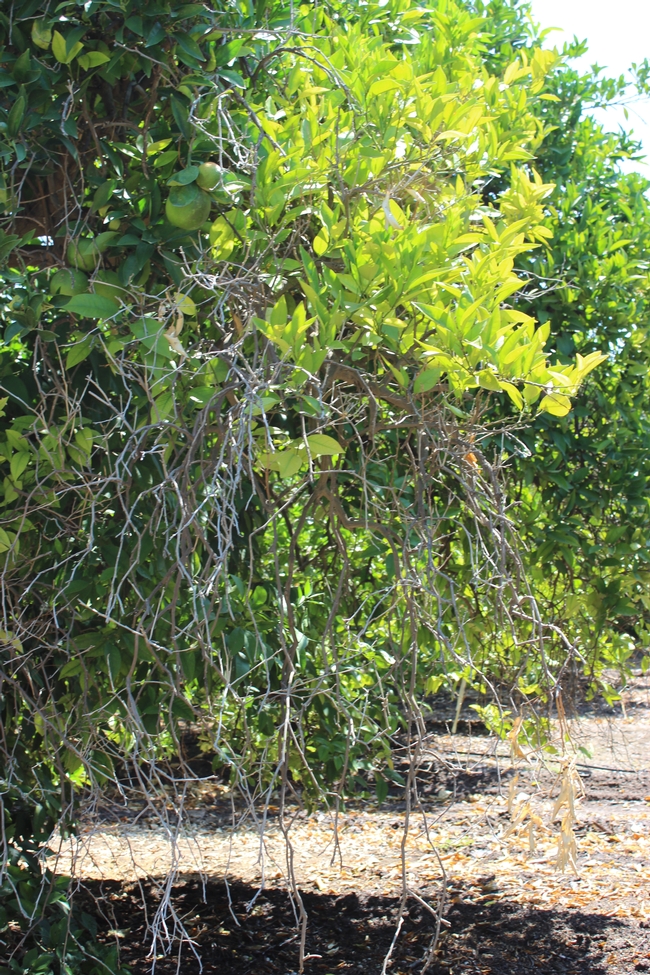
iron dieback citrus
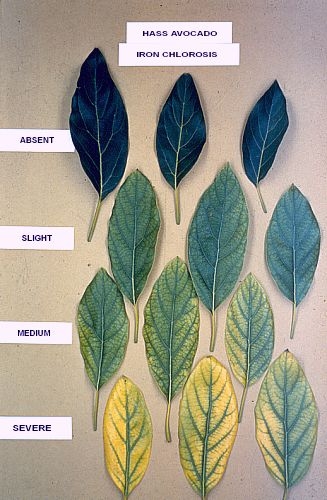
avocado chlorosis
New Early Detection of Citrus HLB
Kearney Research and Extension Center, University of California Cooperative Extension
California is the major producer of fresh market citrus in the U.S., a $2 billion industry that is threatened by a devastating disease called citrus Huanglongbing (HLB). Unfortunately, there is no cure for this disease and if a tree gets infected, it will die in a few years. In Florida, HLB was first seen in 2005, but after a few years the entire state of Florida got infected. Today, about 60% of Florida citrus has gone, mostly because there was no efficient HLB monitoring practice. HLB diagnosis using laboratory-based methods required manual sampling and they were time and effort consuming. An efficient HLB management requires high spatial and temporal resolution monitoring and eradication of infected trees. Therefore, a diagnosis sensor is needed for detecting HLB infected canopies before the development of symptoms. For high resolution monitoring, the sensor should also be able to conduct rapid and inexpensive inspection with high accuracy.
Starch accumulation in HLB infected leaves is an early indication of the disease. Starch has an optical characteristic of rotating the polarization plane of light. We employed this characteristic of starch to develop an early detection methodology in which the sensing system was very sensitive to the rotation in polarization plane of light. The sensor has a customized illumination system including 10 high-power and narrow band LEDs at 591 nm and a polarizing film. The sensor also has a monochrome camera equipped with a linear polarizing filter that is set in a perpendicular direction to the polarizing film of the illumination system.
Starch accumulation in an HLB infected leaf generates blotchy mottle in an asymmetrical yellowing pattern. Deficiency of certain nutrients such as Mg and Zn causes symptoms similar to HLB.
The sensor was mounted on a gator vehicle and was tested in a citrus grove in Florida. The polarized images acquired from healthy, HLB, and Zn deficient canopies were further analyzed for diagnosis purpose.
HLB samples were accurately identified from healthy and Zn deficient samples. Also, the sensor was able to detect HLB within Zn deficient samples.
The polarized imaging methodology was adopted in two separate studies at the University of Florida to investigate the earliest time HLB can be diagnosed by polarized imaging technique after infection. In one study, two-year old Valencia orange plants were inoculated using disk-graft method.
Time-lapse polarized images of leaves from inoculated citrus plants were acquired on a weekly basis. HLB symptoms (as starch accumulation) started to become visible in the polarized images five weeks after inoculation, while the plants were still in asymptomatic stage.
In another study, the polarized imaging methodology was employed to detect HLB in insect inoculated citrus seedlings while in asymptomatic stage. Citrus seedlings were exposed to intensive HLB-positive Asian Citrus Psyllid (ACP) feeding. Polarized images were acquired two times; once after one month after inoculation and again two months after inoculation. As well as HLB detection, the level of infection was obtained for different leaf samples. Polymerase chain reaction (PCR) tests were conducted to validate the HLB status and the level of infection in each leaf sample.
Currently, we focus on improving the accuracy and early detection performance of the polarized imaging sensor and developing a commercialized product for practical in-field diagnosis. This affordable tool can help the California citrus growers to protect their groves from HLB.
Photos, from top to bottom:
Sensor Prototype
Leaf Symptoms of HLB and Zn Deficiency
Time Lapse Images of HLB Infected Leaves Over Time
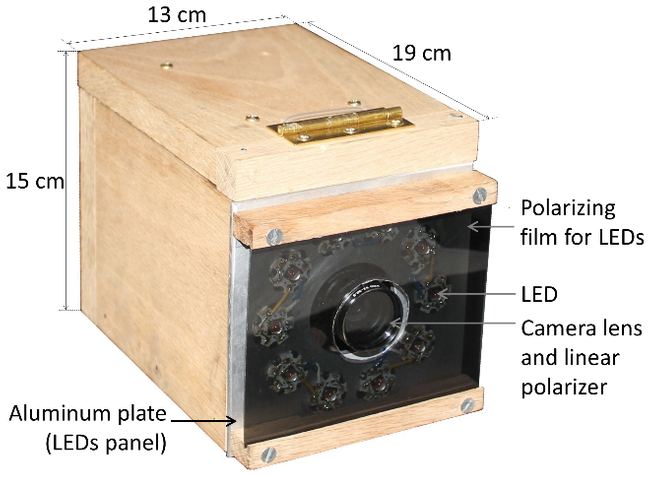
Detection Sensor Prototype HLB
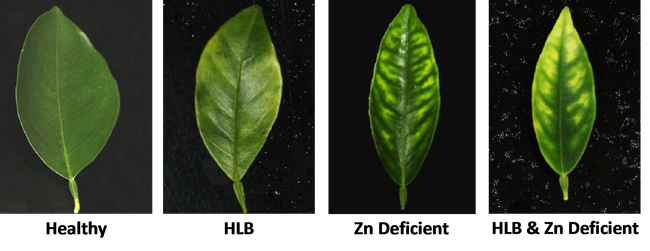
HLB healthy and Zn deficient
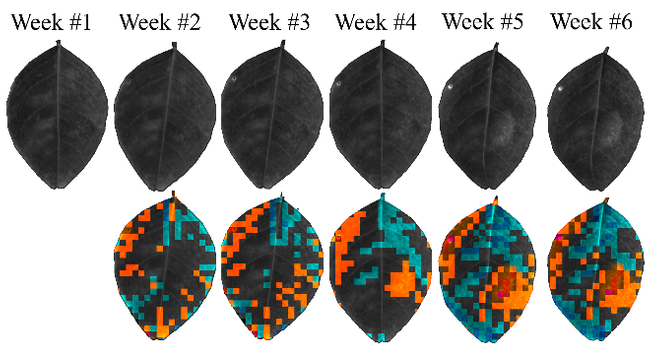
HLB leaves starch
Drought Induced Problems in Our Orchards
Drought Induced Problems in Our Orchards
Abiotic disorders are plant problems that are non-infective. They are not caused by an organism, but through their damage, they may bring on damage caused by organisms. Think of a tree hit by lightning or a tractor. The damage breaches the protective bark which allows fungi to start working on the damaged area, eventually leading to a decayed trunk. It was the mechanical damage, though that set the process in motion.
Too much or too little water can also predispose a plant to disease. Think of Phytophthora root rot or even asphyxiation that can come from waterlogging or too frequent irrigations.
Salinity Effects from Lack of Water
Lack of water and especially sufficient rainfall can lead to salinity and specific salts like boron, sodium and chloride accumulating in the root zone. This happens from a lack of leaching that removes native soil salts from the root zone or the salts from the previous salt-laden irrigation from the root zone. These salts cause their own kind of damage, but they can also predispose a tree to disorders, disease and invertebrate (insect and mite) damage.
Lack of water and salt accumulation act in a similar fashion. Soil salt acts in competition with roots for water. The more soil salt, the harder a tree needs to pull on water to get what it needs. The first symptom of lack of water or salt accumulation may be an initial dropping of the leaves. If this condition is more persistent, though we start to see what is called “tip burn” or “salt damage”. Southern California is tremendously dependent on rainfall to clean up irrigation salts, and when rain is lacking, irrigation must be relied on to do the leaching
As the lack of leaching advances (lack of rainfall and sufficient irrigation leaching) the canopy thins from leaf drop, exposing fruit to sunburn and fruit shriveling.
Leaf drop and fruit shriveling in avocado.
In the case of sensitive citrus varieties like mandarins, water stress can lead to a pithy core with darker colored seeds, almost as if the fruit had matured too long on the tree.
Total salinity plays an important factor in plant disorder, but also the specific salts. These salts accumulate in the older leaves, and cause characteristic symptoms that are characteristic in most trees. Boron will appear on older leaves, causing an initial terminal yellowing in the leaf that gradually turns to a tip burn.
Often times it is hard to distinguish between chloride, sodium and total salinity damage. It is somewhat a moot point, since the method to control all of them is the same – increased leaching. There is no amendment or fertilizer that can be applied that will correct this problem. The damage symptoms do not go away until the leaf drops and a new one replaces it. By that time hopefully rain and/or a more efficient irrigation program has been put in place.
The Impact of Drought on Nutrient Deficiencies
Salinity and drought stress can also lead to mineral deficiencies. This is either due to the lack of water movement carrying nutrients or to direct completion for nutrients. A common deficiency for drought stressed plants is nitrogen deficiency from lack of water entraining that nutrient into the plant.
This usually starts out in the older tissue and gradually spreads to the younger tissue in more advanced cases.
The salts in the root zone can also lead to competition for uptake of other nutrients like calcium and potassium. Apples and tomatoes are famous for blossom end rot when calcium uptake is low, but we have also seen it in citrus. Low calcium in avocado, and many other fruits, leads to lower shelf life. Sodium and boron accumulation in the root zone can lead to induced calcium deficiencies and increased sodium can also further lead to potassium deficiencies. Leaching can help remove these competitive elements.
Drought Effect on Tree Disease
Drought and salt stress can also lead to disease, but in many cases once the problem has been dealt with the disease symptoms slowly disappear. They are secondary pathogens and unless it is a young tree (under three years of age) or one blighted with a more aggressive disease, the disease condition is not fatal. Often times, in the best of years, on hilly ground these diseases might be seen where water pressure is lowest or there are broken or clogged emitters. The symptoms are many – leaf blights, cankers, dieback, gummosis – but they are all caused by decomposing fungi that are found in the decaying material found in orchards, especially in the naturally occurring avocado mulch or artificially mulched orchards. Many of these fungi are related Botryosphaerias, but we once lumped then all under the fungus Dothiorella. These decay fungi will go to all manner of plant species, from citrus to roses to Brazilian pepper.
Another secondary pathogen that clears up as soon as the stress is relieved is bacterial canker in avocado. These ugly cankers form white crusted circles that ooze sap, but when the tree is healthy again, the cankers dry up with a little bark flap where the canker had been.
Drought Effect on Pests
Water/salt stress also makes trees more susceptible to insect and mite attack. Mites are often predated by predacious mites, and when there are dusty situations, they can't do their jobs efficiently and mites can get out of hand. Mite damage on leaves is often noted in well irrigated orchards along dusty picking rows
Many borers are attracted to water stressed trees and it is possible that the Polyphagous and Kuroshio Shot Hole Borers are more attracted to those trees.
And then we have conditions like Valencia rind stain that also appears in other citrus varieties. We know it will show up in water stressed trees, but we aren't sure what the mechanism that causes this rind breakdown just at color break. Could it be from thrips attracted to the stressed tree or a nutrient imbalance, it's not clear?
Water and salt stress can have all manner of effects on tree growth. It should lead to smaller trees, smaller crops and smaller fruit. The only way to manage this condition is through irrigation management. Using all the tools available, such as CIMIS, soil probes, soil sensors, your eyes, etc. and good quality available water are the way to improve management of the orchard to avoid these problems.
Scroll down for Images
Tip Burn, notice sun burn bottom right hand fruit
Endoxerosis with dried out core
Boron toxicity
Nitrogen deficiency
Blossom end rot
Potassium deficiency
Bot gumming in lemon
Black Streak in Avocado
Bacterial Canker
Citrus red mite
Polyphagous Shot Hole Borer damage on avocado
Valencia Rind Stain

avocado drought canopy
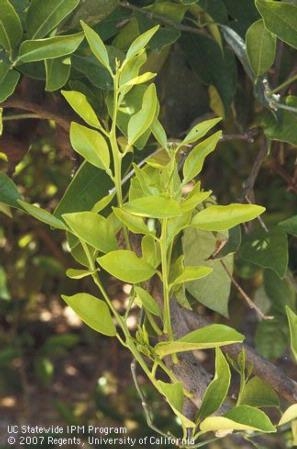
nitrogen deficiency

endoxerosis 4

boron toxicity citrus 1
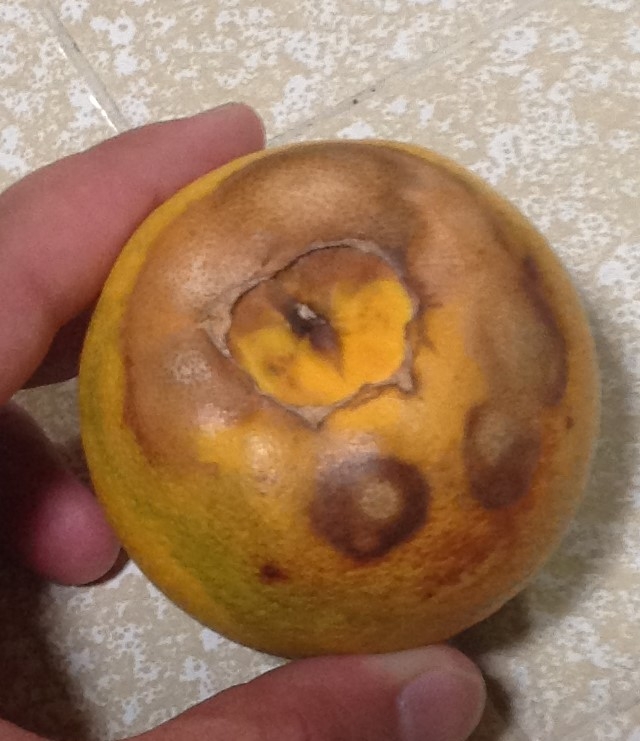
blossom end rot lemon

potassium deficiency avocado

gumming dothiorella

avocado black streak 1

bacterial canker avocado

citrus red mite

PSHB damage
Copper Deficiency in 'Meyer' Lemon - It Can be Gross
A 'Meyer' lemon should be quite happy along the coast, unless it gets planted in new soil that has low copper because of high soil pH or high organic matter. And then you wonder what is wrong.
Mild copper deficiency is usually associated with large, dark green leaves on long soft angular shoots. Young shoots may develop into branches which appear curved or “S-shaped," referred to as “ammoniation” usually resulting from excessive nitrogen fertilization. It's actually thought to be too much nitrogen relative to copper in the plant and can be corrected by foliar sprays. Twigs can develop blister-like pockets of clear gum at nodes. As twigs mature, reddish brown eruptions may occur in the outer portion of the wood. It can be quite shocking. Severely affected twigs commonly die back from the tip with new growth appearing as multiple buds or “witches broom”. Necrotic-corky areas on the fruit surface may sometimes occur in extreme situations. In some cases fruit cracking occurs with exudates.
Copper deficiency is more likely to occur in new plantings on previously uncropped soils, which are usually deficient or totally lacking in copper. In California, it has been referred to as “corral” disease or “midden” disease because it is associated with high organic matter that ties up the copper, or old Native American sites were debris had been piled. It is often localized in certain areas. Once I saw it on nursery trees that had had inadequate copper in the nutrient solution. I've only seen it on citrus, and not any other subtropical like avocado, but that doesn't mean it can't happen.
I've also seen gummosis similar to this occurring with drought and water management. It more commonly occurs as a twig die back at the tips. And certainly Phytophthora gummosis will show gumming. It's that little gumming pocket under the bark is usually the way to distinguish copper deficiency from these two others.
Pictures: pocket gumming (U. of Florida), oozing (Yara), gumming, and more gumming not a worm
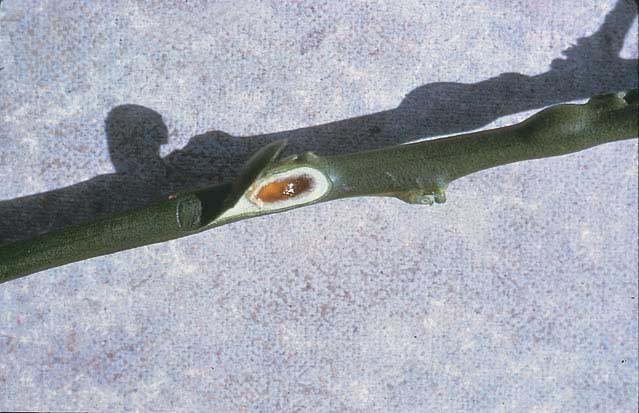
copper deficiency

copper deficicney 2

copper deficiency 3

copper deficiency 4
Blossom End Rot in Citrus - Another Result of Drought
Another impact of the drought? There have been reports of a sunken, leathery patch around the blossom end (opposite of the stem end) of citrus fruit. This has been reported on lemons, limes and mandarins, but I am sure growers are seeing it on oranges, as well as other citrus relatives. This is an abiotic problem caused by a lack of calcium to the fruit, a problem with the plant's growing conditions, not a disease. This is a serious disorder found in various fruits and vegetables, such as tomatoes, melons, peppers and eggplants
Blossom-end rot begins as small tan, water soaked lesions on the blossom end of the fruit. The lesion enlarges and becomes sunken, dark, and leathery. On peppers, the lesion is more commonly found on the side of the fruit towards the blossom end. Also, on peppers it can be sometimes confused with sun scald. Fruit infected by blossom-end rot ripen often become infected with secondary organisms such as Alternaria spp (most likely the surrounding tissue in the photo below).
This is a physiological disorder of low calcium in the fruit. Calcium is required for normal cell growth and in relatively high concentration for new tissue growth. Rapidly growing fruit will begin to breakdown at the blossom end because that is the last place of the fruit tissue to receive calcium and also the area with the lowest concentration of calcium.
In rapidly growing plants, calcium cannot move to those rapidly growing areas quickly enough. Because calcium moves with water, fluctuations in water supply can cause blossom-end rot. Large fluctuations in soil moisture inhibit uptake and movement of calcium within the plant. Excessive nitrogen promotes rapid plant growth, which can cause low concentrations of calcium to occur in plant tissue. Leaf tissue can often not disclose a low calcium in fruit because of the lag in movement of calcium to the rapidly growing fruit tissue.
Other causes such as low calcium levels in the soil or high amounts of cations in the soil which compete with calcium uptake can also cause blossom-end rot. This is especially true in areas of soils derived from serpentine rock that are high in magnesium. The magnesium competes with calcium uptake.
Proper fertilization and water management help to minimize this problem. Avoid over fertilizing the crop. Also avoid allowing the soil to become too dry and then overly wet. Wide fluctuations in soil moisture inhibit calcium uptake and movement. If calcium is deficient or high salts occur in the soil, gypsum applications can help, but delayed uptake may not help fruit tissue content. Often, foliar applications of calcium may be beneficial.

blossom end rot lemon
